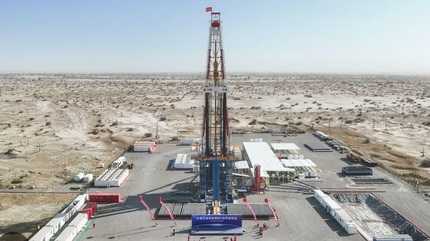
URUMQI, March 5 (Xinhua) -- China has achieved a significant breakthrough in deep-Earth exploration with the drilling of a superdeep borehole in the Xinjiang Uygur Autonomous Region exceeding the 10,000-meter mark, making it the deepest vertical well in Asia, even though the project as a whole is not yet completed.
Amid the continuous humming of the drilling rig, the number on an electronic screen in the command center reached the milestone of 10,000 meters at 2:48 p.m. on Monday. More than a hundred workers on site, who had eagerly anticipated this moment, erupted into cheers.
Located in the hinterland of the Taklimakan Desert in the Tarim Basin, "Shenditake 1" is a scientific exploratory borehole with a designed depth of 11,100 meters. In addition to searching for oil and gas resources, it is also tasked with pursuits such as exploring the evolution of Earth.
Min Peng, director of the drilling platform, could not contain his excitement. "There was hardly any comparable drilling data for reference at such depths, and no technical parameters to rely on, yet we still managed to achieve it," he said.
Situated between the Tianshan and Kunlun mountains, the Tarim Basin has a rich accumulation of deep-seated oil and gas. But it is also one of the most difficult areas to explore due to its harsh surface environment and complicated underground conditions.
Since the start of drilling on May 30, 2023, the borehole has penetrated 13 continental strata, with more than 1,000 drill pipes driven into the Earth and over 20 drill bits consumed in the process, while the difficulty of drilling has escalated as the depth increased.
"It took nearly 5 months to drill from the surface to a depth of 8,000 meters, while it took over 4 months to drill from 8,000 meters to 10,000 meters," said Wang Chunsheng, chief expert of the Tarim Oilfield of China National Petroleum Corporation, which is in charge of the drilling.
After exceeding 10,000 meters, the drilling will face even more severe challenges, such as temperatures of over 200 degrees Celsius and formation pressure exceeding 130 MPa, said Wang.
"In such an environment, the drill pipes behave like cooked noodles, making them difficult to control. Workers can only rely on experience to make judgments and carry out operations," Wang added.
Facing a world-class challenge, the Tarim Oilfield established an interdisciplinary work platform with nine technical support teams and equipped them with top-notch tools.
According to Li Yahui, chief designer of the "Shenditake 1" drilling rig, the independently developed automated drilling rig has a load capacity of over 900 tonnes and is capable of reaching depths of up to 12,000 meters. A number of core technologies for drilling superdeep wells, such as ultra-high-temperature drilling fluid, have also been developed.
"Going deeper into the Earth is a crucial strategic choice for securing China's energy supply," said Sun Jinsheng, an academician of the Chinese Academy of Engineering.
In recent years, China has been continuously breaking records in terms of deep-Earth development. In 2023 alone, more than 70 wells drilled in the Tarim Oilfield had reached depths exceeding 8,000 meters, delivering a total production of 19.57 million tonnes of ultra-deep oil and gas.
The deepest vertical well in the world today, located in Russia, has a depth of 12,262 meters. Jia Chengzao, an academician at the Chinese Academy of Sciences, said "Shenditake 1" has become the second-deepest vertical well worldwide and is of milestone significance in deep-Earth scientific research and ultra-deep oil and gas exploration.
After reaching 10,000 meters, the drilling at "Shenditake 1" persists at full throttle towards its target depth of 11,100 meters.




